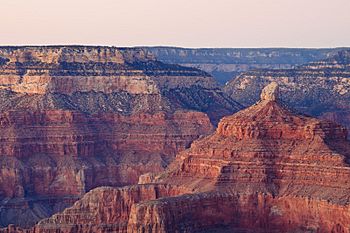Hermit Formation facts for kids
Quick facts for kids Hermit FormationStratigraphic range: Permian, Early Leonardian 275–270Ma |
|
|---|---|

(Isis Temple, central Grand Canyon)
The 3 top geologic units visible: 3)-(white-cliffs-prominence)-Coconino Sandstone, 2)-(slope-forming-Deep brnsh-red)-Hermit Formation, 1)-(red-uppermost-vertical-cliff & resistant)-Esplanade Sandstone (top unit of 4–member Supai Group) (Note: Distinctive Redwall Limestone upper horizontal-platform.) |
|
| Type | Geological formation |
| Underlies | Coconino Sandstone |
| Overlies | Supai Group |
| Thickness | 900 feet (270 m), at maximum |
| Lithology | |
| Primary | siltstone and mudstone |
| Other | sandstone |
| Location | |
| Region | |
| Country | |
| Type section | |
| Named for | Hermit basin, Coconino County, Arizona |
| Named by | Noble (1923) |
The Hermit Formation, also known as the Hermit Shale, is a type of rock layer. It was formed during the Permian period, which was about 275 to 270 million years ago. This rock layer is not very hard, so it often forms gentle slopes.
It is mostly made of reddish-brown siltstone (rock made from tiny silt particles) and mudstone (rock made from mud). You can also find very fine-grained sandstone (rock made from sand) within it.
Contents
What is the Hermit Formation?
The Hermit Formation is a special rock layer found in places like the Grand Canyon. It's known for its reddish-brown color and soft, crumbly nature. This means it doesn't form steep cliffs like some other rock layers. Instead, it creates sloped areas.
What is it made of?
The main materials in the Hermit Formation are:
- Siltstone: This is like hardened mud, but with slightly larger particles than clay.
- Mudstone: This is also hardened mud, very fine-grained.
- Sandstone: This is rock made from sand, and in the Hermit Formation, the sand grains are very tiny.
In the upper parts of the Hermit Formation, especially in the Grand Canyon, you might see white and red layers. These layers are made of sandstone and siltstone that contain calcium carbonate, which is found in things like seashells. These layers sometimes show "low-angle cross-bedding". This means the layers are tilted, showing how ancient sand dunes or river sediments were laid down by wind or water.
Ancient Rivers and Plants
The Hermit Formation often has beds of dark red, crumbly siltstone. These fill what are called "paleochannels". A paleochannel is like an ancient riverbed or stream channel that has been filled in and turned into rock. These old channels are quite common in this rock layer.
Inside these siltstone beds, scientists have found fossils of plants. These fossils are often not perfectly preserved, but they give clues about the types of plants that lived millions of years ago in this area.
Where is the Hermit Formation Found?
The Hermit Formation is found in the Southwestern United States. You can see it in:
- Arizona, especially in the Grand Canyon and near Sedona, Arizona.
- Southeastern California.
- Southern Utah.
How Thick is it?
The thickness of the Hermit Formation changes from place to place.
- In the eastern part of the Grand Canyon, it's about 100 feet (30 m) thick.
- In the western Grand Canyon, near Toroweap and Shivwits Plateaus, it can be as thick as 900 feet (270 m).
- Near Sedona, Arizona, it's usually around 300 feet (91 m) thick.
How it Connects to Other Rock Layers
The Hermit Formation sits between two other important rock layers:
- Above it: The Coconino Sandstone. The top of the Hermit Formation meets the Coconino Sandstone very sharply. There isn't a gradual change from one rock type to the other.
- Below it: The Supai Group. The bottom of the Hermit Formation rests on top of the Supai Group. This contact is a special type of break in the rock record called a "disconformity". This means there was a period of erosion before the Hermit Formation was laid down. This erosion created an uneven surface, like ancient valleys, sometimes as deep as 60 feet (18 m).

